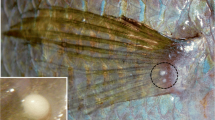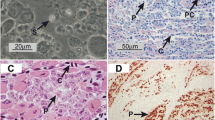Abstract
Purpose
To follow the development of the microsporidian Spraguea americanus within the nervous tissue of Lophius. An attempt to determine when and how the infection begins.
Methods
Acquiring different age groups of Lophius and recovering the infected sites, particularly the supramedullary neuron fibers and preparing them for microscopy.
Results
The youngest juvenile Lophius recovered were 140 mm long with established infections. These infections consisted of meronts and sporoblasts but no spores. The evidence indicates these infections began a month or so earlier.
Conclusions
Early stages of S. americanus development occur only in juvenile Lophius and not present in older fish. The prediction is infections of all Spraguea species begin early in the life of benthic juvenile Lophius. The high incidence of infection among these fish is an indicator that the location where the infection begins is likely rich in infective spores.





taken from 500 mm fish. The parasite colonies characteristically have a rich web of IFs. The blowup would indicate the filaments attached to the surface of the spores. a, b Bars = 1 µm
Similar content being viewed by others
References
Caruso H (1985) The systematics and distribution of the Lophiid anglerfishes: III Intergeneric relationships. Copeia 4:870–887
Weissenberg R (1976) Microsporidian interaction with host cells. In: Bulla L, Cheng TC (eds) Biology of the microsporidia. Comparative pathobiology, vol 1. Springer, Boston, pp 203–237
Freeman M, Yokoyoma M, Ogawa K (2004) A microsporidian parasite of the Genus Spraguea in the nervous tissues of the Japanese anglerfish, Lophius Litulon. Folia Parasitol 51:167–176. https://doi.org/10.14411/lp.2004.020
Funakoshi K, Abe T, Kishida R (1995) Trigeminal, vagal and spinal projections o Supramedullary cells in the pufferfish, Takifugu niphobles. J Comp Neurol 358:52–562. https://doi.org/10.1002/cne.903580408
Mola L, Sassi S, Cuogh B (2002) The supramedullary cells of the teleosts Coris julis: a noradrenergic neuronal system. Eur Histochem 46:329–332. https://doi.org/10.4081/1744
Wediner E, Sokolova Y, Overstreet R (2020) Microsporida can acquire lamin-like intermediate filaments and cell adhesion catenin-cadherin-complexes the host cell. J. Eukaryote Microbiol 67:583–592
La Mesa M, de Rossi F (2008) Ealy life history of the black anglerfish Lophius budegassa Spinola 1807 in the Mediterranean Sea using otolith Microstructure. Fish Res 93:234–239. https://doi.org/10.1016/j.fishres.2008.05
Colmenero A, Tuset V, Sanchez P (2017) Reproductive strategy for white Anglerfish Lophius piscatorius in Mediterranean waters: implications for Management. Fish Bull 115:60–73. https://doi.org/10.7755/FB.115.l.6
Tinino A (1923) Lophius. Eports on the Danish Oceanographic Expeditions 1908–1910 To the Mediterranean and adjacent sea. Biology and Fred, vol 2. Host & Son, Copenhagen, pp 1–29
Weidner E (2000) Cytoplasmic proteins on surface of discharged Microsporidian sporoplasm. Biol Bull 199:208–209. https://doi.org/10.2307/1542902
Weidner E (2001) Microsporidian spore/sporoplasm dynactin in Spraguea. Biol Bull 201:245–246. https://doi.org/10.2307/1543346
Weidner E, Overstreet R (2021) Peculiar outer membrane with exterior Cytoplasmic proteins. Acta Parasit. https://doi.org/10.1007/s11686-00446-9
Moles A, Jensen K (2000) Prevalence of the sockeye salmon brain parasite Myxobolus arcticus in selected Alaskan streams. Alaska Fish Bull 6:85–93
Acknowledgements
Special thanks to Richard Weissenberg—he got me started on this back in 1970; he did his doctorate on this parasite in anglerfish in 1907. He received his training from Oscar Hertwig who figured out how fertilization works in 1875; and guess what—he got his training with Ernest Haeckel who as everybody knows read ‘Origin of the Species’ when it first came out; he rushed over to Down and had a nice visit with Darwin and Huxley; to Bill Trager who introduced me to Woods Hole—and, to Horace Stunkard who did life cycles in Woods Hole till he was 100.
Author information
Authors and Affiliations
Corresponding author
Ethics declarations
Conflict of Interest
The author declares that he had no conflict of interest.
Ethical Approval
This article does not contain any studies with human participants performed by the author.
Additional information
Publisher's Note
Springer Nature remains neutral with regard to jurisdictional claims in published maps and institutional affiliations.
Rights and permissions
About this article
Cite this article
Weidner, E. The Spraguea Parasitism in Anglerfishes of the Genus Lophius. Acta Parasit. 67, 943–946 (2022). https://doi.org/10.1007/s11686-022-00546-0
Received:
Accepted:
Published:
Issue Date:
DOI: https://doi.org/10.1007/s11686-022-00546-0




